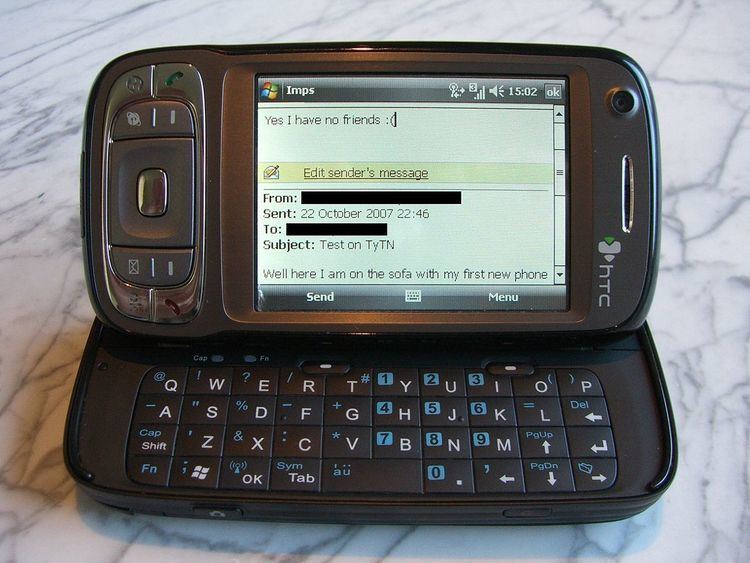Manufacturer HTC Corporation | ||
 | ||
Compatible networks Quad band GSM 850/900/1800/1900, GPRS, EDGETri band UMTS 850/1900/2100, HSDPA, HSUPAaGPS Availability by country September 2007; 9 years ago (2007-09) Discontinued September 3, 2009 (2009-09-03) | ||
The HTC TyTN II (also known as the HTC Kaiser, the HTC P4550, and the HTC 8925) is an Internet-enabled Windows Mobile Pocket PC smartphone designed and marketed by HTC Corporation of Taiwan. It has a tilting touchscreen with a right-side slide-out QWERTY keyboard. The TyTN II's functions include those of a camera phone and a portable media player in addition to text messaging and multimedia messaging. It also offers Internet services including e-mail, instant messaging, web browsing, and local Wi-Fi connectivity. It is a quad-band GSM phone with GPRS, EDGE, UMTS, HSDPA, and HSUPA.
Contents
Video driver issues
Soon after its release to market, reviewers and end users reported the TyTN II's graphical performance was below par. Both 2D and 3D graphics were affected, with notable symptoms being poor video playback and severely low frame-rates when running 3D applications and games. The hardware platform (Qualcomm 7200 chipset) suggested that the device was capable of high graphical performance, however the device was consistently outperformed by older HTC devices.
A community of enthusiast developers investigated the cause of the poor performance and concluded that DirectDraw and Direct3D applications were running in software rendering mode only. No hardware acceleration was taking place, and the drivers required to take advantage of the ATI Imageon hardware appeared to be missing.
Many users within the community were dissatisfied by the apparent omission of a video driver that would allow hardware acceleration of graphics, particularly since the device included rendering hardware which was not being used. In an attempt to elicit interest from developers with relevant expertise, the community began raising a bounty which could be offered to any developer (or team of developers) who could solve the problem by enabling hardware acceleration with a homebrew driver. A website was also established to document and publicize the problem, to pressure HTC to provide a fix, and ultimately start a class action lawsuit against the manufacturer.
At least one developer is working to get proper driver support working at HTCClassAction.org. They have successfully created a driver that enables hardware acceleration under specific circumstances (everything but fullscreen). Right now the driver enables D3D and OpenGL ES. This driver does not solve any 2D drawing problems (GUI and menus). The driver does prove that the TyTN II based devices do in fact have functioning GPU accelerated hardware, and it is enabled. It is also important to note that these drivers only work on ROMs based on Windows Mobile 6.1.
Some developers are now working to enable 2D DDI support for the Polaris, which could lead to support for the Kaiser. They are using files obtained from the G810 ROM(s).
Also, some users have upgraded to the driver present in the Samsung Omnia. This driver also uses software rendering, but it has been properly optimized for the ARM architecture.
Versions
Besides the branding differences, there are several models of the HTC TyTN II: the KAIS100, the KAIS110, the KAIS120, and the KAIS130. The KAIS110 has no camera; the KAIS100 has a 3.1 megapixel rear-facing camera; the KAIS120 and KAIS130 have a 3.1-megapixel rear-facing camera and a 0.3-megapixel front-facing camera.
The TyTN II model was sold as:
ROM updates
The TyTN II shipped with Windows Mobile 6.
Official updates are available for several versions of the TyTN II, including the AT&T Tilt (WM 6 AKU 0.4.4), the O2 XDA Stellar (WM 6.1), and the Vodafone v1615.
Developers at XDA-Developers have succeeded in porting Google Android and Windows Mobile 6.5 to the TyTN II.
Specifications
Preloaded software
(Varies by operator)
GPS compatibility
Users of this phone have successfully installed and used other GPS map software applications (such as ALK Technologies CoPilot Live 7, DeLorme Street Atlas USA 2009, Fugawi, Garmin Mobile XT, Google Maps Mobile, iNav iGuidance, Intrisync Destinator, Microsoft Live Search Mobile, TomTom, Tracky, and VisualGPS BeeLineGPS), which are either free or cost nothing beyond the original purchase price. The map applications are compatible with the built-in GPS receiver, provided users set the appropriate COM port for the map application (COM4, 4800 baud).
The built-in GPS receiver was intended by some wireless providers to be used preferably with Telenav, which is a service that charges users monthly fees or fees based on the amount of downloaded map data. It should be noted that Telenav can only provide map data in areas where applicable cellular phone services are available and that users must have a data plan with their wireless providers.
